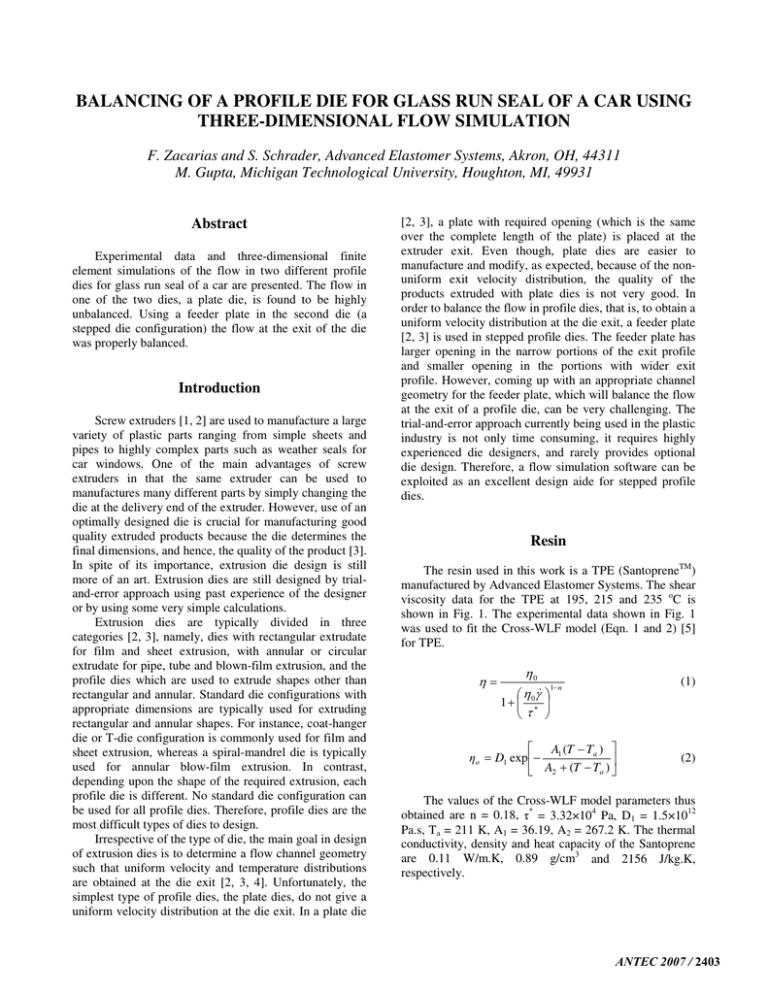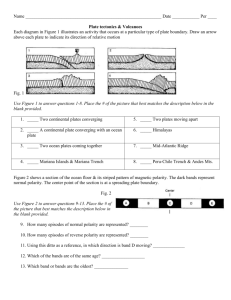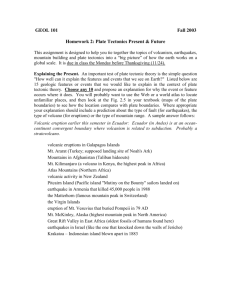BALANCING OF A PROFILE DIE FOR GLASS RUN SEAL OF... THREE-DIMENSIONAL FLOW SIMULATION
advertisement

Page 1 of 4 BALANCING OF A PROFILE DIE FOR GLASS RUN SEAL OF A CAR USING THREE-DIMENSIONAL FLOW SIMULATION F. Zacarias and S. Schrader, Advanced Elastomer Systems, Akron, OH, 44311 M. Gupta, Michigan Technological University, Houghton, MI, 49931 Abstract Experimental data and three-dimensional finite element simulations of the flow in two different profile dies for glass run seal of a car are presented. The flow in one of the two dies, a plate die, is found to be highly unbalanced. Using a feeder plate in the second die (a stepped die configuration) the flow at the exit of the die was properly balanced. Introduction Screw extruders [1, 2] are used to manufacture a large variety of plastic parts ranging from simple sheets and pipes to highly complex parts such as weather seals for car windows. One of the main advantages of screw extruders in that the same extruder can be used to manufactures many different parts by simply changing the die at the delivery end of the extruder. However, use of an optimally designed die is crucial for manufacturing good quality extruded products because the die determines the final dimensions, and hence, the quality of the product [3]. In spite of its importance, extrusion die design is still more of an art. Extrusion dies are still designed by trialand-error approach using past experience of the designer or by using some very simple calculations. Extrusion dies are typically divided in three categories [2, 3], namely, dies with rectangular extrudate for film and sheet extrusion, with annular or circular extrudate for pipe, tube and blown-film extrusion, and the profile dies which are used to extrude shapes other than rectangular and annular. Standard die configurations with appropriate dimensions are typically used for extruding rectangular and annular shapes. For instance, coat-hanger die or T-die configuration is commonly used for film and sheet extrusion, whereas a spiral-mandrel die is typically used for annular blow-film extrusion. In contrast, depending upon the shape of the required extrusion, each profile die is different. No standard die configuration can be used for all profile dies. Therefore, profile dies are the most difficult types of dies to design. Irrespective of the type of die, the main goal in design of extrusion dies is to determine a flow channel geometry such that uniform velocity and temperature distributions are obtained at the die exit [2, 3, 4]. Unfortunately, the simplest type of profile dies, the plate dies, do not give a uniform velocity distribution at the die exit. In a plate die [2, 3], a plate with required opening (which is the same over the complete length of the plate) is placed at the extruder exit. Even though, plate dies are easier to manufacture and modify, as expected, because of the nonuniform exit velocity distribution, the quality of the products extruded with plate dies is not very good. In order to balance the flow in profile dies, that is, to obtain a uniform velocity distribution at the die exit, a feeder plate [2, 3] is used in stepped profile dies. The feeder plate has larger opening in the narrow portions of the exit profile and smaller opening in the portions with wider exit profile. However, coming up with an appropriate channel geometry for the feeder plate, which will balance the flow at the exit of a profile die, can be very challenging. The trial-and-error approach currently being used in the plastic industry is not only time consuming, it requires highly experienced die designers, and rarely provides optional die design. Therefore, a flow simulation software can be exploited as an excellent design aide for stepped profile dies. Resin The resin used in this work is a TPE (SantopreneTM) manufactured by Advanced Elastomer Systems. The shear viscosity data for the TPE at 195, 215 and 235 oC is shown in Fig. 1. The experimental data shown in Fig. 1 was used to fit the Cross-WLF model (Eqn. 1 and 2) [5] for TPE. = 0 1+ o = D1 exp 0 & 1 n A1 (T Ta ) A2 + (T Ta ) (1) (2) The values of the Cross-WLF model parameters thus obtained are n = 0.18, * = 3.32×104 Pa, D1 = 1.5×1012 Pa.s, Ta = 211 K, A1 = 36.19, A2 = 267.2 K. The thermal conductivity, density and heat capacity of the Santoprene are 0.11 W/m.K, 0.89 g/cm3 and 2156 J/kg.K, respectively. ANTEC 2007 / 2403 Page 2 of 4 Die Geometry The geometry of a profile die for extrusion of a glass run seal for window of a car was analyzed in this work. The geometry of the die exit profile for extrusion of the glass run seal is shown in Fig. 2. The geometry of the profile die in Fig. 2 is quite complex. In particular, thickness of the tabs at the ends of the U-shaped profile is much smaller than the main body of the profile. Furthermore, thickness of the right leg is significantly larger than the thickness of the left leg, and is also larger that that of the bottom of the U-shaped profile. Therefore, velocity distribution at the die exit is expected to be highly unbalanced if a simple plate die is used for extruding the glass run seal. The geometry of the feeder plate used to balance the flow in the die for the glass run seal is shown in Fig. 3. Fig. 3 shows the rear view of the stepped die. Therefore, the thicker right leg in Fig. 2 is on the left side in Fig. 3. The stepped die in Fig. 3 and the plate die in Fig. 2 have the same opening at the exit. In order to balance the flow at the die exit, the feeder plate for the stepped die in Fig. 3 has the same opening thickness for both legs of the Ushaped profile, which slows down the flow rate in the right leg. To further balance the flow in the die, the flow in the thinner lips in the U-shaped profile was accelerated by machining local cylindrical feeders at these locations. The plate die in Fig. 2 has a length of 2.54 cm. The stepped die in Fig. 3, which is 2.05 cm long, is an actual production die currently being used to manufactures TPE glass run seal for window of a car. Experimental Extruded Profile Fig. 4 shows the extrudate profile obtained from the two different dies. The black (dashed) line shows the profile obtained from the plate die, whereas the profile obtained by the stepped die is shown by red (solid) line. It is noted that for the profile extruded by using the plate die both the legs of the U-shaped cross-section are smaller than those in the profile obtained using the stepped die. Also, size of the lips at the ends of the U-shaped profile, where the cylindrical channels were drilled to accelerate the polymer, is thicker in the profile obtained by using the stepped die. Numerical Simulation The PELDOMTM software [6 – 9] was used to simulate the flow in the plate die and the stepped die shown in Figs. 2 and 3, respectively. For both dies, a constant velocity corresponding to the flow rate of 50 kg/hr was enforced at the entrance. The polymer temperature at the die inlet was 477.4 K (203.4 oC), 2404 / ANTEC 2007 whereas the die wall temperature was 472 K (199 oC). Fig. 5 shows the predicted velocity distributions in three different cross-sections of the two profile dies. The outer cross-sections in Fig. 5 are at the entrance (right) and exit (left) of the two dies, with the third cross-section being at the centre of the dies. In the plate die in Fig 5 (a), because of the wider die opening, the velocity at the exit is much larger in the right leg. Furthermore, since the effective thickness of the die profile increases near a T-joint, the velocity is also quite high in the T-joint region of the left leg in Fig. 5 (a). As expected, the velocity in the thinner lips at the ends of the U-shaped profile is smaller than the velocity at the exit in the rest of the plate die. Since the opening in the right leg of the feeder plate is smaller, the exit velocity in the thicker right leg of the stepped die in Fig. 5 (b) is significantly reduced in comparison to that in the plate die. Also, because of the six circular channels which were drilled at the ends of the U-shaped profile in the feeder plate, flow rate is larger in the tabs at the end of the profile. In general, the velocity distribution at the exit of the stepped die in (Fig, 5 b) is much more uniform than that at the exit of the plate die (Fig. 5 a). The predicted pressure distributions in the two profile dies are shown in Fig. 6. Even though, the pressure distribution in the plate die (Fig. 6 a) and stepped die (Fig. 6 b) look quite different, the difference in the two distributions is not as large as it appear. The sudden drop in the pressure near the entrance of the two dies is because of the constant velocity (corresponding to 50 kg/hr) specified at the entrance of the dies. As the flow develops quickly from the uniform velocity distribution specified at the die entrance to a fully developed velocity distribution, it results in the sharp pressure drop near the entrance. If this sharp pressure drop near the die entrance is ignored, the total pressure drop in both the dies is about 3.5 Mpa. For the two dies, Fig. 7 shows the predicted temperature distribution in the three different crosssectional planes. The temperature distributions in the two dies are quite similar. Starting at 477.4 K (203.4 oC), due to viscous disruptions, in both dies the temperature increases to about 480 K (207 oC) at certain locations at the die exit. It is noted that in the stepped die in Fig. 7 (b) the temperature in the right leg is maximum near the midplane. In contrast, in the right leg of the plate die in Fig. 7 (a), the temperature is not the maximum in the mid-plane, but in a thin layer near the die walls. Such a layer of hot polymer is often formed due to viscous dissipations in channel flows similar to that in the plate die [10]. It is clearly evident from the results and discussion about that a flow simulation software is a powerful tool for predicting the velocity, pressure and temperature distributions in a profile die, and for modifying the die geometry accordingly before the actual die is cut such that a balanced flow is obtained at the die exit. Without such a software, the current trial-and-error approach typically require five to ten design iterations, which is very Page 3 of 4 expensive and time consuming, and at best provides only a sub-optimal die design. Conclusions PELDOM software was used for flow simulation in two different profile dies. The flow in a plate die for a glass run seal of a car was found to be highly unbalanced. The flow in the profile die was successfully balanced by using a feeder plate in a stepped die. In general, a threedimensional flow simulation software can be exploited as an effective tool for design of profile dies. Fig. 2 Exit profile of the die for extruding glass run seal of a car. References 1. Z. Tadmor and I. Klien, Engineering Principles of Plasticating Extrusion, Van Nostrand Reinhold, New York (1971). 2. C. Rauwendaal, Polymer Extrusion, Hanser Publishers, New York (1994). 3. W. Michaeli, Extrusion Dies for Plastics and Rubber, Hanser publishers, New York (1992). 4. Y. Sun and M. Gupta, Int. Polym. Proc., 20, 380 (2005). 5. C. A. Hieber, in Injection and Compression Molding Fundamentals, A. I. Isayev (Ed.), Marcel Dekker, New York (1987). 6. PELDOM, Plastic Flow, LLC, Houghton, MI 49931. 7. Y. Sun and M. Gupta, Int. Polym. Proc., 18, 356 (2003). 8. Y. Sun, M. Gupta, J. Dooley, K. A. Koppi and M. A. Spalding, SPE Annual Tech. (ANTEC) Papers, 51, 81 (2005). 9. Y. Sun and M. Gupta, Adv. Polym. Tech., 25, 90 (2006). 10. R.B. Bird, R. C. Armstrong and O. Hassager, Dynamics of Polymeric Liquids, Vol 1. Wiley, New York (1987) Viscosity (Pa.s) 10000 T = 195 oC, Experiment T = 215 oC, Experiment T = 235 oC, Experiment T = 250 oC, Experiment T = 195 oC, Cross-WLF T = 215 oC, Cross-WLF T = 235 oC, Cross-WLF T = 250 oC, Cross-WLF 1000 Fig. 3 Rear view of the stepped die. Fig. 4. Shape of the extrudate profile from the two different dies. Plate die: black line. Stepped die: red line. 100 10 10 100 1000 10000 Shear Rate (1/s) Fig. 1 Viscosity of Santoperene. ANTEC 2007 / 2405 Page 4 of 4 (a) Velocity distribution in the profile dies, (a) plate die, (b) stepped die. (b) Fig. 5 (a) Pressure distribution in the profile dies, (a) plate die, (b) stepped die. (b) Fig. 6 (a) Temperature distribution in the profile dies, (a) plate die, (b) stepped die. (b) Fig. 7 2406 / ANTEC 2007



